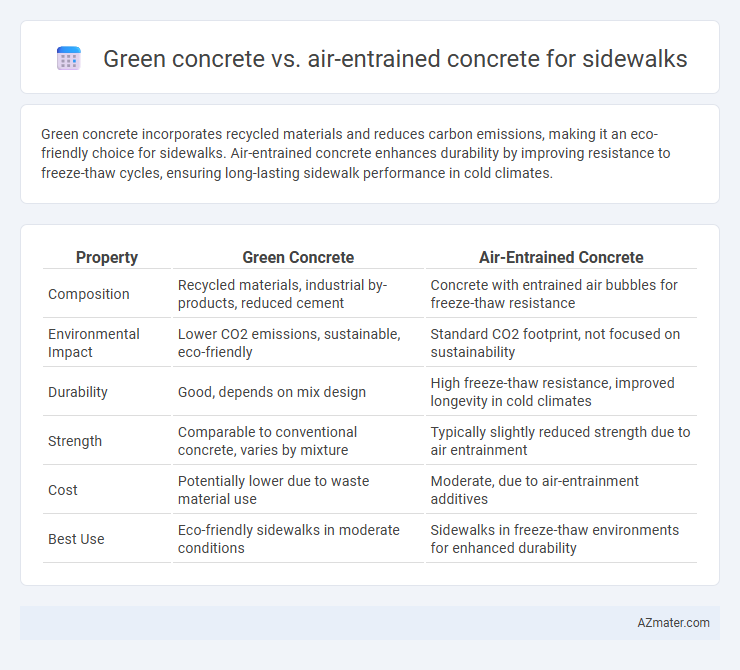Green concrete incorporates recycled materials and reduces carbon emissions, making it an eco-friendly choice for sidewalks. Air-entrained concrete enhances durability by improving resistance to freeze-thaw cycles, ensuring long-lasting sidewalk performance in cold climates.
Table of Comparison
| Property | Green Concrete | Air-Entrained Concrete |
|---|---|---|
| Composition | Recycled materials, industrial by-products, reduced cement | Concrete with entrained air bubbles for freeze-thaw resistance |
| Environmental Impact | Lower CO2 emissions, sustainable, eco-friendly | Standard CO2 footprint, not focused on sustainability |
| Durability | Good, depends on mix design | High freeze-thaw resistance, improved longevity in cold climates |
| Strength | Comparable to conventional concrete, varies by mixture | Typically slightly reduced strength due to air entrainment |
| Cost | Potentially lower due to waste material use | Moderate, due to air-entrainment additives |
| Best Use | Eco-friendly sidewalks in moderate conditions | Sidewalks in freeze-thaw environments for enhanced durability |
Introduction to Green Concrete and Air-Entrained Concrete
Green concrete incorporates recycled materials like fly ash and slag to reduce environmental impact while maintaining strength and durability, making it an eco-friendly alternative for sidewalk construction. Air-entrained concrete contains microscopic air bubbles to improve freeze-thaw resistance, enhancing durability in cold climates where sidewalks are exposed to cycles of freezing and thawing. Comparing these types emphasizes sustainability benefits of green concrete against the enhanced durability of air-entrained concrete, impacting material selection for sidewalks based on environmental conditions and performance requirements.
Key Ingredients and Composition Differences
Green concrete incorporates recycled materials such as fly ash, slag, and recycled aggregates, reducing environmental impact by lowering cement content and carbon footprint. Air-entrained concrete contains microscopic air bubbles introduced by air-entraining agents like vinsol resin or synthetic detergents to enhance freeze-thaw durability in sidewalks. The primary compositional difference lies in the substitution of traditional cement with supplementary cementitious materials in green concrete versus the controlled entrainment of air within the concrete matrix for air-entrained concrete.
Sustainability and Environmental Impact
Green concrete incorporates recycled materials and industrial byproducts, significantly reducing carbon footprint and resource consumption compared to traditional air-entrained concrete. Its enhanced sustainability profile minimizes landfill waste and conserves natural aggregates, making it ideal for eco-friendly sidewalk construction. While air-entrained concrete improves freeze-thaw durability, green concrete offers superior environmental benefits by mitigating greenhouse gas emissions and promoting circular economy practices.
Durability and Longevity Comparison
Green concrete, incorporating recycled materials and industrial by-products, enhances sustainability without compromising strength, exhibiting excellent durability in freeze-thaw cycles due to improved microstructure. Air-entrained concrete introduces microscopic air bubbles that improve resistance to freeze-thaw damage, significantly extending the sidewalk's longevity in cold climates by preventing internal cracking. Comparing the two, air-entrained concrete typically offers superior durability in harsh weather conditions, while green concrete provides comparable lifespan benefits with added environmental advantages, making the choice dependent on specific project requirements and climate factors.
Freeze-Thaw Resistance in Sidewalk Applications
Green concrete incorporates recycled materials and supplementary cementitious components that enhance its durability and freeze-thaw resistance, making it suitable for sidewalk applications in cold climates. Air-entrained concrete improves freeze-thaw resistance by introducing microscopic air bubbles that accommodate water expansion during freezing cycles, reducing surface scaling and cracking. For sidewalks subject to frequent freeze-thaw conditions, air-entrained concrete typically offers superior performance, while green concrete provides an environmentally friendly alternative with competitive durability characteristics.
Workability and Placement Considerations
Green concrete incorporates supplementary cementitious materials like fly ash or slag, enhancing workability by improving the mix's cohesiveness and reducing water demand, which facilitates easier placement for sidewalks. Air-entrained concrete introduces microscopic air bubbles to improve freeze-thaw resistance, but may slightly reduce workability, requiring adjustments in admixture dosages to maintain flowability during sidewalk pouring. Selecting between green and air-entrained concrete depends on balancing environmental benefits with placement ease and durability needs in sidewalk construction.
Cost Implications for Municipal Projects
Green concrete, made with recycled materials and industrial byproducts, offers long-term cost savings in municipal sidewalk projects due to reduced material costs and lower environmental fees. Air-entrained concrete, while generally more expensive initially because of its admixtures, provides enhanced durability in freeze-thaw conditions, potentially decreasing maintenance and replacement expenses. Evaluating upfront costs against lifecycle savings is essential for municipalities aiming to optimize budgets while ensuring sidewalk longevity.
Performance in Urban Sidewalk Environments
Green concrete offers enhanced sustainability with lower carbon emissions and improved thermal insulation, making it suitable for energy-efficient urban sidewalks. Air-entrained concrete provides superior freeze-thaw durability and resistance to de-icing chemicals, essential for maintaining sidewalk integrity in cold urban climates. Performance in urban sidewalk environments depends on balancing environmental benefits of green concrete against the robust durability of air-entrained mixes under harsh weather conditions.
Maintenance and Lifecycle Assessment
Green concrete reduces maintenance costs for sidewalks by incorporating recycled materials that enhance durability and reduce crack formation, extending the pavement's lifespan. Air-entrained concrete improves freeze-thaw resistance, lowering surface scaling and maintenance frequency in cold climates, but may have a shorter lifecycle compared to green concrete due to environmental stressors. Lifecycle assessments indicate green concrete offers a lower carbon footprint and longer service life, making it a sustainable choice for sidewalk applications with reduced long-term maintenance.
Conclusion: Choosing the Right Concrete for Sidewalks
Green concrete offers enhanced sustainability by incorporating recycled materials and reducing carbon emissions, making it an eco-friendly choice for sidewalks. Air-entrained concrete provides superior freeze-thaw durability, preventing cracking and extending the lifespan in cold climates. Selecting the right concrete depends on balancing environmental goals with performance needs, where green concrete suits environmentally conscious projects and air-entrained concrete excels in regions with harsh winter conditions.

Infographic: Green concrete vs Air-entrained concrete for Sidewalk
 azmater.com
azmater.com